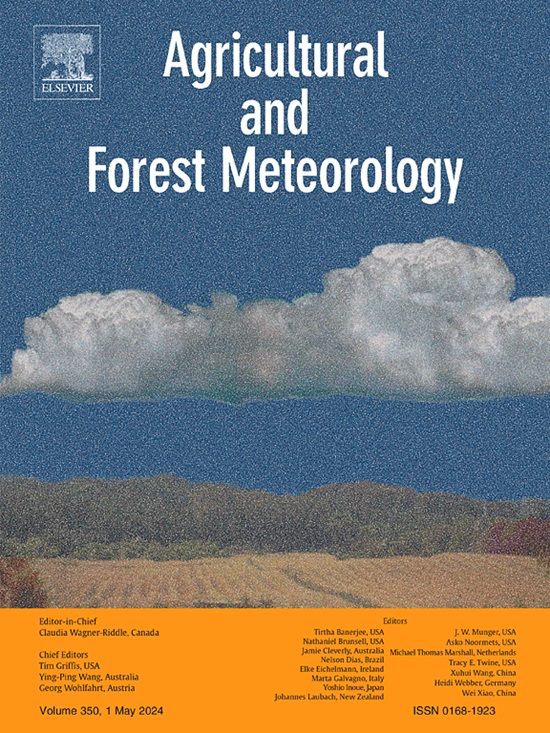Climate and vegetation jointly determine the interannual variation of net ecosystem CO2 fluxes over 12 years in a restored coastal wetland
IF 5.7
1区 农林科学
Q1 AGRONOMY
引用次数: 0
Abstract
Wetland CO₂ sinks represent a long-term, effective strategy for mitigating climate change and enhancing carbon sequestration. Many regions have adopted ecological restoration practices, such as “returning farmland to wetlands” to strengthen the CO₂ uptake capacity of ecosystems. However, the respective contributions of vegetation dynamics and climatic factors to ecosystem CO₂ sequestration during this process remain poorly understood. This study utilizes 12 years of CO2 flux data, meteorological data, and remote sensing imagery from a restored coastal salt marsh to investigate how vegetation and climate jointly influence net ecosystem exchange (NEE) across multiple time scales and different restoration durations. The results demonstrate that both vegetation and climate provide critical insights into NEE dynamics. Integrating vegetation and climate data enhances the accuracy of NEE predictions, indicating their combined influence on ecosystem CO₂ sequestration. As the time scale increases, vegetation exerts progressively stronger control over NEE, although climatic factors remain the primary driver of its variation. Moreover, vegetation recovery during restoration enhances its regulatory effect on NEE, gradually reducing the relative influence of climate. These findings deepen our understanding of the mechanisms driving NEE of CO2 and offer valuable guidance for predicting and optimizing coastal wetland carbon sink functions.
气候和植被共同决定了恢复后滨海湿地12年生态系统净CO2通量的年际变化
湿地CO₂汇是减缓气候变化和增强碳固存的一种长期有效的策略。许多地区采取了“退耕还林”等生态恢复措施,以增强生态系统的二氧化碳吸收能力。然而,在这一过程中,植被动态和气候因子对生态系统CO 2固存的各自贡献尚不清楚。利用海岸带盐沼恢复后12年的CO2通量数据、气象数据和遥感影像,研究了植被和气候在不同时间尺度和不同恢复时间下对净生态系统交换(NEE)的共同影响。结果表明,植被和气候都为东北东线动力学提供了重要的见解。整合植被和气候数据提高了新能源经济预测的准确性,表明它们对生态系统CO 2固存的综合影响。随着时间尺度的增加,植被对东北东线的控制逐渐增强,但气候因子仍然是其变化的主要驱动因素。恢复过程中植被的恢复增强了其对净净能源的调节作用,逐渐降低了气候的相对影响。这些发现加深了我们对NEE驱动机制的理解,并为滨海湿地碳汇功能的预测和优化提供了有价值的指导。
本文章由计算机程序翻译,如有差异,请以英文原文为准。
求助全文
约1分钟内获得全文
求助全文
来源期刊
CiteScore
10.30
自引率
9.70%
发文量
415
审稿时长
69 days
期刊介绍:
Agricultural and Forest Meteorology is an international journal for the publication of original articles and reviews on the inter-relationship between meteorology, agriculture, forestry, and natural ecosystems. Emphasis is on basic and applied scientific research relevant to practical problems in the field of plant and soil sciences, ecology and biogeochemistry as affected by weather as well as climate variability and change. Theoretical models should be tested against experimental data. Articles must appeal to an international audience. Special issues devoted to single topics are also published.
Typical topics include canopy micrometeorology (e.g. canopy radiation transfer, turbulence near the ground, evapotranspiration, energy balance, fluxes of trace gases), micrometeorological instrumentation (e.g., sensors for trace gases, flux measurement instruments, radiation measurement techniques), aerobiology (e.g. the dispersion of pollen, spores, insects and pesticides), biometeorology (e.g. the effect of weather and climate on plant distribution, crop yield, water-use efficiency, and plant phenology), forest-fire/weather interactions, and feedbacks from vegetation to weather and the climate system.

 求助内容:
求助内容: 应助结果提醒方式:
应助结果提醒方式:


